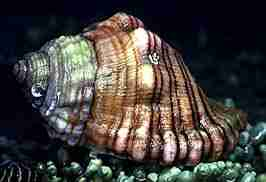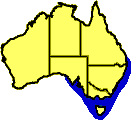|
|
Spengler's Rock Whelk Cabestana spengleri
Form:
 A
distinctive feature of the shell of Spengler's Rock Whelk are the pairs
of brown-red lines between the spiral ridges in the grooves.
A
distinctive feature of the shell of Spengler's Rock Whelk are the pairs
of brown-red lines between the spiral ridges in the grooves.
This shell is large, very solid, elongate, and strongly sculptured. The spire is elevated and conical. The shell is sculptured by broad spiral ridges, with large nodules or keels in the centre of the whorls. These whorls are crossed by many fine cross ridges. The grooves are marked with brown-red to brown lines, often in pairs. There is often an abrupt break on the body whorl, which implies a long pause in the shell growth. The outer lip is swollen, and the spiral ribs extend beyond its edge. The operculum is horny.
The photograph is of a dead shell. The live animal is covered by a thin, brown, hairy epidermis called a periostracum.
Colour:
The shell colour is yellowish-brown, with a white inner lip and columella.
Phylum: |
Mollusca |
Author: |
Perry, 1811 |
Family: |
Cymatiidae |
Size: |
100-150 mm |
Distribution:
 Southern
Queensland, around southern Australia to South Australia, including Tasmania
and New Zealand.
Southern
Queensland, around southern Australia to South Australia, including Tasmania
and New Zealand.
Habitat:
Locally common, this large carnivorous mollusc often occurs in crevices and rock pools at low tide levels and below.
It is often found eating cunjevoi an ascidian, and polychaete worms.
The dead shells are often found trapped in gutters and in beach debris. SpenglerŐs Rock Whelk was used as food by Aborigines and the shell remains are commonly found in cooking middens.
Questions:
What colour is this animal's shell in its natural habitat ?
What is an epidermis and what is it's purpose ?
What is a periostracum and what does it do ?
What other molluscs have a periostracum ?
References:
Bennett, I. (1987) W.J. Dakin's classic study: Australian Seashores. p. 230, 253-5, Angus & Robertson, Sydney.
Davey, K. (1998) A Photographic Guide to Seashore Life of Australia. p.108, New Holland, Sydney.
Edgar, G.J. (1997) Australian Marine Life: the plants and animals of temperate waters. p.255, Reed Books, Kew.
Quinn, G.P., Wescott, G.C. & Synnot, R.N. (1992) Life on the Rocky Shores of South-Eastern Australia: an illustrated field guide. p.53, Victorian National Parks Association, Melbourne.
Marine Research Group of Victoria (1984) Coastal Invertebrates of Victoria: an atlas of selected species. p.54, Museum of Victoria, Melbourne.
Macpherson, J.H. & Gabriel, C.J. (1962) Marine Molluscs of Victoria. p.159, Melbourne University Press & The National Museum of Victoria.
Shepherd, S.A. & Thomas, I.M. (1982) Marine Invertebrates of Victoria, Pt. 1. p.590, South Australian Government Printer, Adelaide.
Underwood, A.J. & Chapman, M.G. (1993) Seashores: a beachcomber's guide. p.43, New South Wales University Press, Sydney.
Wilson, B.R. & Gillett, K. (1979) A field guide to Australian Shells: Prosobranch Gastropods. p.129, A.H. & A.W. Reed, Sydney.
Molluscs
Tritons, Whelks
& Spindle Shells
Home
Page
Taxonomy
Biogeography
Rocky Shores
Tidal Levels
Intertidal Zonation
Environmental Factors
Biological
Factors
Feeding Relationships
Activities
Glossary
References
 Life
on Australian Seashores
Life
on Australian Seashores
by Keith Davey (C) 2000
Learning Consultant
- Media
The University of Newcastle
email at australian_seashores@hotmail.com
Scientific Consultant: Phil
Colman
site created 01.01.98 : updated 01.04.2000
